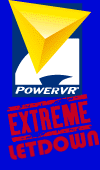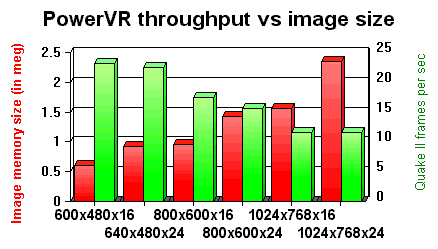
 |
So You're Stuck with a PowerVR |
![]()
 The PowerVR, or more exactly, PowerVR2 architecture has got
to be the most misunderstood, overhyped 3D chipset ever produced.
"A Voodoo-class card for $50 less!" Well, let's set
this straight, once and for all.
The PowerVR, or more exactly, PowerVR2 architecture has got
to be the most misunderstood, overhyped 3D chipset ever produced.
"A Voodoo-class card for $50 less!" Well, let's set
this straight, once and for all.
NO ONE, AT ANY TIME, SHOULD BUY A POWERVR2-BASED
CARD. EVER.
|
Thus the trap - the people who are too cheap to pay the extra $50 for
a 3Dfx card are people who saved up for a P-133, much less a P-200,
and are going to get performance on par with Clinton's moral standards.
Everything else you ever heard bad about a PowerVR2 is more or less true, also. There is a serious 'tiling' effect, where the walls look like they are made out of lego's, because there are only 16 levels of brightness. And there's no true colored lighting, in the sense that iD and god intended. All in all, if you buy a PowerVR2 card, you're a fool. And yes, I know. I was a fool. |
But I already have one!
Don't look so glum! Believe it or not, this is the site for PowerVR victims, I mean, owners. Even as pathetic as this card is, in fact, there's a bright side to this story that most people never hear about.
It's true. Most 3D card reviewers write something like the above. And they're not kidding. They are honestly trying to help you. But they're generally not engineers, and any and all reviews should be taken with a salt block. There were so many conflicting stories, we decided the only thing to do was buy all of the cards. (At the time, an m3D, Canopus Pure3D and Diamond Viper V330.)
By the time we got around to testing the PVR2, it until it was too late to return it, so we were stuck with it. And we still had it when a new Pentium-II 300 Mhz system came in.
And everything changed.
You mean it isn't worthless?
Well, not exactly. The PowerVR architecture is VERY cpu dependent. Which means unless you have an incredibly fast CPU, it isn't worth used toad spit. But if you have the fastest CPU you can buy, well, that's different. The idea here is to take the $50 you saved over buying a Voodoo card and put it towards a $600 P-II/333 Mhz processor.
|
Now that you've bought your 64 Meg, 300+ Mhz system, you have a
workable PVR2 system. And you know? It's not bad. Not bad at all.
In actual day to day use, the PowerVR has some real benefits.
Take a look at these Quake II timedemo figures.
Please note, these are WITH sound active. In fact, I reran the numbers with Netscape 4.0, Eudora and Telnet all running at the same time (no change.) These are real numbers you can expect in play, because real people play with the sound on. |
PowerVR results:
Core system is a P-II/300, 64 Meg, Stealth 3D 4M VRAM video, Matrox m3D, Soundblaster AWE64 Gold, 6.4 Gig UDMA drive driving a Hitachi 21" SuperScan Pro. |
The numbers don't lie. The PowerVR architecture has some strange benefits.
PowerVR supports real f$%#^ing resolutions!
This is the #1 complaint with 3Dfx. What is with their love affair
with resolutions we banned from Windows years ago? 640 x 480?
What a joke! That's the emergency VGA fallback resolution!
We haven't sold a system that supported less than 1152x864x16 bit
in years. If I wanted pixels the size of crayon marks, I'd buy
an N64.
PowerVR2 Quake II, running in 1024x768 resolution, looks just awesome. Slow, but playable. In a recent deathmatch, I was sniping people with the railgun so far out they couldn't see me as a character. I was probably 2 pixels high to them. The human eye will fill in a lot of information, but trust me, it's a LOT happier when it doesn't have to.
PowerVR runs 24-bit color almost as fast as 16-bit color!
Bizarre but true, the performance penalty for PVR2 24-bit mode is
so low you might as well stay in 24-bit color. And yes, it very
definitely looks better. In fact, PowerVR transparent water displays
none of the 'pattern' effect you see in Quake I's "timedemo demo2" on
Voodoo and Riva cards. 16-bit color has aliasing patterns that become
seamlessly perfect in 24-bit mode. So crank it up!
PowerVR doesn't need to use 8-bit textures!
Well, that, or it can't! It's hard (read: impossible) to detect
the difference, but there is no speed penalty for sticking with
true 16-bit textures in Quake.
PowerVR doesn't need a PCI slot!
Ok, that's a joke, but I read in a British review a trick that
is in fact the coolest Cheap PowerVR Trick you'll ever see.
The PowerVR card is thin. REAL thin. There's nothing on it. There are no external connectors because the PowerVR processor only has texture memory on the card. (4 Meg, Cal! ;-) Instead of putting video out, it writes across the PCI bus directly to your main video card, which already has X Meg of frame buffer on it (for your desktop graphics modes.)
Now on a modern PCI motherboard, generally, there is a shared slot. There are 4 PCI and 4 ISA slots, but the center ISA and PCI slots share a cutout on the back of the case. That is, you can make it EITHER a PCI card, or an ISA card. But if you're like me, there aren't any slots free to give up.
Enter the world's cheapest PVR2 trick. Simply take the slot cover off of the PVR2 card. It's so thin and light, it will easily plug into the shared PCI slot while you have an ISA card in the ISA side! You'll want to be DAMM sure it has enough clearance - at least 1/4". But it's worked in multiple machines for us in the shared slot just fine, freeing up an in-demand PCI slot.
PowerVR doesn't screw up your high resolution video
Many Voodoo owners are unaware, or don't seem to care, but the Voodoo's
pass-through design means your video signal is going not straight through
to the monitor, but through another card, and then on. And this level
of 'indirection' introduces error.
This is most noticable at high resolutions like 1280x1024 and 1600x1200. In fact, Canopus suggests placing the Voodoo card and the video card as far apart in the PCI slots as possible to reduce video display corruption.
That's great, but we didn't spend $2000 on a super high end 21" monitor just so the game card could trash the display! 3Dfx isn't the first chipset vendor to abandon the high end - the Riva 128 (nVidia) architecture can't support 1280x1024x24-bit color, the standard 21" mode, even though it's fast enough and has enough memory.
The tiling effect is actually kinda cool
There. It's done. I've said it, publicly.
Zanshin made no end of comments beating on the fact that, because PowerVR only has 16 levels of brightness, there is a severe tiling effect you see all over the place. And it's true. But you know, after playing a lot on the PowerVR and Voodoo side by side, I'm learning to really like it.
It didn't work so well in Quake, but in Quake II, the tiling effectively adds detail. Yeah, it's the wrong detail, but not THAT wrong. A lot of places are just walls, with the same, huge texture stretching along for hundreds of virtual feet. On the Voodoo, that's what you see. But on PowerVR, the tiling effect makes it look more constructed, as if there were access panels and building details. And after a while, the Voodoo look just looked kinda, well, plain. This is mostly a Quake II thing, where most of the backgrounds are concrete and steel the effect meshes well.
Did we mention it runs Q II in a window?
Yes it does. In fact, I've run teeny weeny 320x240 Quake in
a window on my 1280x1024x24 bit desktop, acting as a Q II server for
some multiplayer testing over the Internet. And it runs fine too.
Nothing quite so bizarre as pointing to the little window and going,
"oh yeah, that's the server."
YOU DONT GET THESE RESULTS WITHOUT AT LEAST
A P-II 300 MHZ OR FASTER SYSTEM.
Don't forget that! If you have a P-133 and read this and think, "Wow, so my PowerVR card doesn't stink?" YES IT DOES. Give it to your dog as a chew toy, save up, and buy a nice used Voodoo card when Voodoo2 hits. (Yet Another Low-res Wonder out of 3Dfx. But it'll cause a flood of cheap Voodoo cards.)
|
Overanalyzing the PowerVR
A pointless but interesting excercise is to compare the PowerVR's throughput versus the screen image size (framebuffer.) Because regardless of resolution or color depth, a graphics accelerator is eventually going to have to fill that memory with an image. |

|
DISCLAIMER: Conklin Systems doesn't make 3D graphics cards. We build systems, and do lots of low-level software development. When it comes to 3D cards, we're just consumers like yourselves, albeit with a very deep understanding of the equipment. As such, this page is opinion and review.
Well, if you got this far, you deserve a prize for your reading skills. Everyone knows those little gold stars in school never cut it, any more than the reading assignments were any kind of challenge. But we can set you up as only Conklin Systems knows how. Don't just sit there!
And it's only fair, since we're sitting here pissing on someone else's product, to give you the same chance to piss on ours. But if you like Quake, you're going to like the:
Metal Logo Paks
The original Metal Logo Paks, as banned (or something) by InternetWeek's senior editor! Get 'em while they're hot.